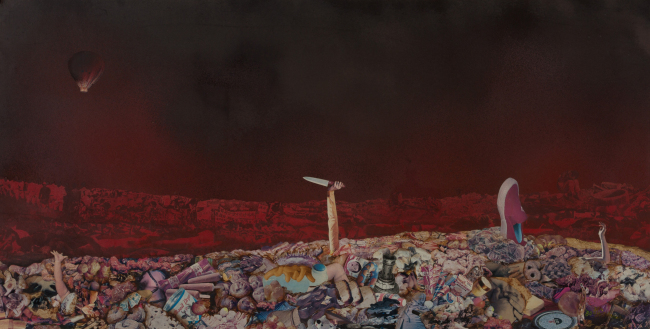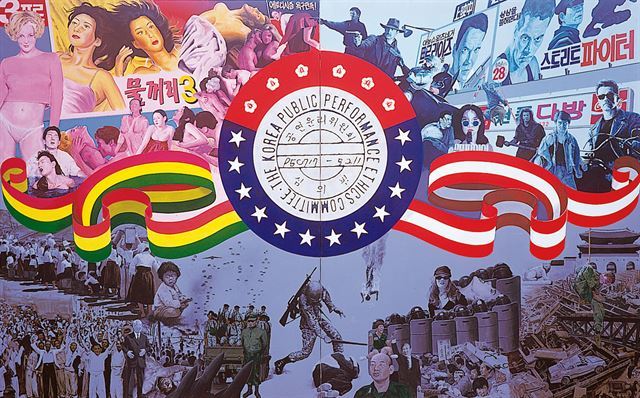Exploring diversity of Korean art
Exhibitions examine minjung, realism art movements in the 1980s and 1990s and more diversified local art scene after 2000s
By KH디지털2Published : Jan. 24, 2016 - 17:51
While Korean monochrome art, dansaekhwa, movement continues to garner international attention as a unique abstract art movement in Asia, curators and art critics in Korea are looking to highlight other important artistic movements.
Gana Art Center is presenting works of eight artists who led the minjung art movement and realism art that reflected Korea’s fast-changing social and political environment in the 1980s and 1990s.
Another exhibition, also backed by Gana Art Foundation, an affiliate of the GAC, highlights a younger generation of artists whose globally recognized experimental artworks cover a wide spectrum of local and global issues.
The “Reinstatement of Realism,” organized by the GAC and scheduled to run from Jan. 28 to Feb. 28 at Gana Insa Art Center in Seoul, presents 100 major works of eight artists whose works portray the diverse faces of Korean society in its shift from authoritarianism to democracy and the country’s opening to the global market.
“This show aims to highlight their artistry and honesty in depicting the unique Korean social and political landscape,” said Lee Ho-jae, chairman of Gana Art Center and founder of Gana Art Foundation, at a press preview of the exhibition last week.
The works featured in this exhibition are strong, aggressive, and sometimes, nostalgic, as they portray social injustice and negative effects or rapid industrialization and farmers whose lives are threatened by the influx of foreign agricultural products for the first time.
Gana Art Center is presenting works of eight artists who led the minjung art movement and realism art that reflected Korea’s fast-changing social and political environment in the 1980s and 1990s.
Another exhibition, also backed by Gana Art Foundation, an affiliate of the GAC, highlights a younger generation of artists whose globally recognized experimental artworks cover a wide spectrum of local and global issues.
The “Reinstatement of Realism,” organized by the GAC and scheduled to run from Jan. 28 to Feb. 28 at Gana Insa Art Center in Seoul, presents 100 major works of eight artists whose works portray the diverse faces of Korean society in its shift from authoritarianism to democracy and the country’s opening to the global market.
“This show aims to highlight their artistry and honesty in depicting the unique Korean social and political landscape,” said Lee Ho-jae, chairman of Gana Art Center and founder of Gana Art Foundation, at a press preview of the exhibition last week.
The works featured in this exhibition are strong, aggressive, and sometimes, nostalgic, as they portray social injustice and negative effects or rapid industrialization and farmers whose lives are threatened by the influx of foreign agricultural products for the first time.

Shin Hak-chul’s narrative painting depicting symbolic events and people in modern history of Korea on a single canvas, show the flow and irony of Korean modern history at a glance. Lee Jong-gu’s realistic paintings of farmers and their lands portray anger, disappointment and dreams of rural farmers on the verge of collapse.
“Back then, the authoritarian Korean government banned the artists from exhibiting their works as they were honest depictions of the society,” explained Yoo Hong-jun, art historian and writer, who specializes in minjung art.
The anti-communist authoritarian government of the time forbade exhibition of works that used a lot of red color -- commonly associated with communism.
The exhibition, in part, seeks to test whether minjung art and realism art, that thrived in the 1980s and 1990s in Korea, would appeal to wider audiences in the Asian art world like China’s political pop movement.
“This group of artists, now in their 50s and 60s, have been active players in the Korean art scene since the 1980s. But they have become overshadowed by dansaekhwa artists, who are now well into their 80s. I think we need to show other aspects of Korean art through works of these artists.”
At Gyeonggi Museum of Modern Art, a group exhibition shedding light on the more diversified art scene post-2000 runs from Feb. 19 to April 3.
“This exhibition is a departure from the two major artistic movements in Korea -- dansaekhwa and minjung art -- and focuses on a third voice,” said Gim Jun-gi, one of the curators of “The Third Zone.”

The exhibition gathers 11 artists, who defied the dominant academic art prevalent in the Korean art circle and sought to find their own artistic identity. They include Kim Ki-ra, Kim Tae-heon, Roe Dong-shik, Bae Jong-heon, Yi Hwan-kwon, Zin Ki-jong, Hong Kyoung-tack.
They seek to distinguish themselves from the other two artistic movements and school connections and faction feuds in the local art world.
The dansaekhwa movement had been formed inside the academia -- the majority of dansaekhwa artists were art professors at major art colleges in Seoul such as Hong Ik University and Seoul National University.
“If you work at the studio of Chung Chang-sup, you somehow get influenced by his style,” said Choi Eun-ju, director of the Gyeonggi Museum of Modern Art.
Chung is one of the leading dansaekhwa artists and former art professor at Seoul National University.
“In the 1980s, art students learned the academic art from dansaekhwa professors inside the campus, but when they went outside, political paintings were everywhere, on the walls, on the streets. It was how Korean art environment was in the 1980s,” Choi recalled.
The artists featured in “The Third Zone” doesn’t belong to the traditional mainstream art circles. This group of artists are among the “globalized” Korean artists who studied overseas in the 1990s and 2000s and whose works were recognized in the global art world in the early 2000s.
“The artists all work with different mediums. Some are critical of social and political issues, but some are not. I think this is the true diversity of 21st century Korean art,” said Hong Kyoung-tack whose hyper-realistic pencil paintings are popular at Christie’s and Sotheby’s art auctions.
Artist Kim Ki-ra added: “It shows a new aspect of contemporary Korean art that is not related to any of the previous art movements, but is about accepting and creating new thoughts and concepts.”
By Lee Woo-young (wylee@heraldcorp.com)



![[Exclusive] Korean military set to ban iPhones over 'security' concerns](http://res.heraldm.com/phpwas/restmb_idxmake.php?idx=644&simg=/content/image/2024/04/23/20240423050599_0.jpg&u=20240423183955)

![[Graphic News] 77% of young Koreans still financially dependent](http://res.heraldm.com/phpwas/restmb_idxmake.php?idx=644&simg=/content/image/2024/04/22/20240422050762_0.gif&u=)



![[Pressure points] Leggings in public: Fashion statement or social faux pas?](http://res.heraldm.com/phpwas/restmb_idxmake.php?idx=644&simg=/content/image/2024/04/23/20240423050669_0.jpg&u=)









